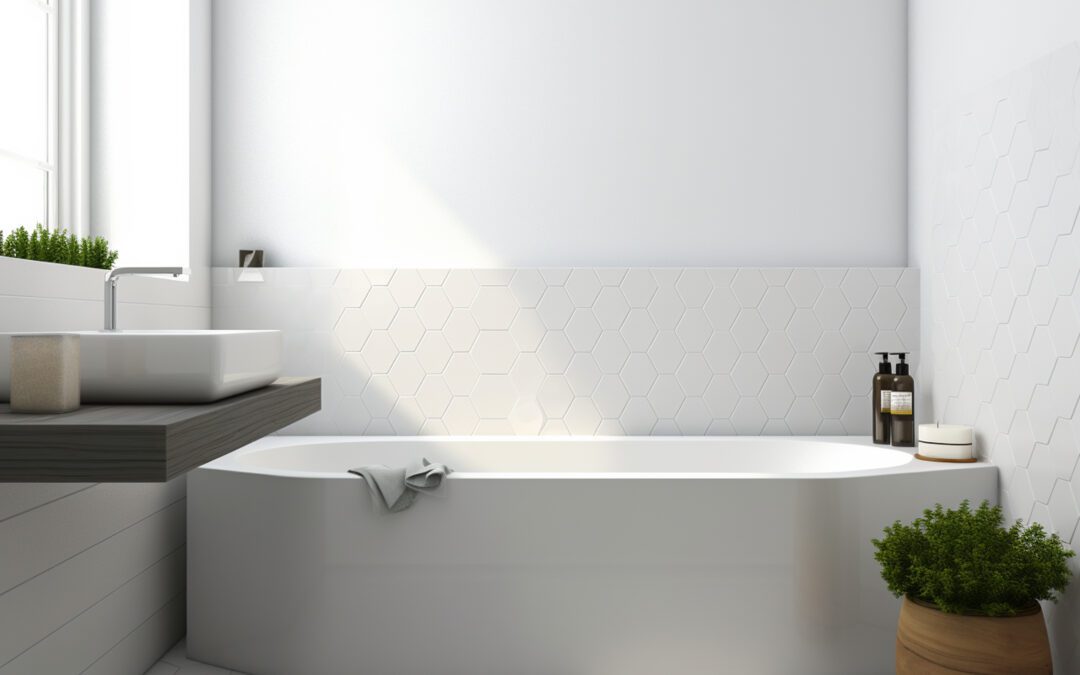Highlights
- Acrylic tubs are made from clear plastic reinforced with fiberglass.
- They’re affordable, durable, and easy to install and maintain.
- Excellent heat retention helps keep bathwater warm.
- Downsides include susceptibility to scratches, stains, and flexing.
- Consult a bathtub installer to see if an acrylic bathtub is right for your home.
If you love relaxing in a warm bath after a long day, an acrylic bathtub is one of the most popular choices for homeowners seeking a balance between style and affordability. These tubs are sleek, lightweight, versatile, and durable—but are they the right fit for your bathroom? Understanding the pros and cons of acrylic tubs will help you make a confident decision as you plan your remodel.
What Is an Acrylic Tub?
Despite the name, acrylic tubs aren’t made from solid acrylic. They’re constructed from clear acrylic plastic that’s reinforced with fiberglass for added strength. Acrylic bathtubs are among the most common types of tubs available today, offered in a wide variety of models including alcove, freestanding, soaking, and corner styles. A professional bathtub installer can help you compare materials and choose the right option for your design goals and budget.
Pros and Cons of Acrylic Tubs
| Pros of Acrylic Tubs | Cons of Acrylic Tubs |
| Low maintenance | Can scratch and stain |
| Excellent heat retention | Sensitive to strong cleaners |
| Easy installation | Limited high-end models |
| Durable | Prone to flexing |
| Cost-effective | May dull over time |
Pros of Acrylic Tubs
Acrylic bathtubs are low-maintenance, simple to install, and budget-friendly. They retain heat well and provide a comfortable, long-lasting bathing experience.
- Low Maintenance
Acrylic tubs are among the easiest bathtub materials to care for. Their nonporous surface resists mold and mildew, and most cleaning can be done with mild bathroom cleaners. Minor scratches can often be repaired by a professional through buffing or refinishing.
- Good Heat Retention
Acrylic retains heat effectively, helping bathwater stay warm for longer. This makes baths more comfortable and energy-efficient, as you won’t need to refill the tub frequently with hot water.
- Easy Installation
Because acrylic tubs are lightweight, they’re easier to transport and install than heavier materials such as cast iron or natural stone. Most bathrooms don’t require additional floor reinforcement for acrylic tub installations.
- High Durability
Reinforced with fiberglass, acrylic bathtubs are strong and resistant to chipping. With proper care, they typically last around 15 years—and in some cases, up to 30 years.
- Affordable
Acrylic tubs offer a stylish yet budget-conscious solution. They’re generally less expensive than solid-surface or natural-stone tubs, with average installation costs around $2,000—roughly half the price of a typical bathtub replacement.
Cons of Acrylic Tubs
While acrylic tubs are durable, they may not offer the same premium quality as materials like porcelain or ceramic. Common drawbacks include surface wear, sensitivity to harsh cleaners, and potential flexing.
- Surface Can Scratch and Stain
Acrylic surfaces are relatively soft, making them more prone to scratches and staining, especially in older tubs or those exposed to hair dye and harsh products. Regular cleaning and maintenance can minimize these issues.
- Damaged by Strong Cleaners
Avoid using abrasive scrubbers or harsh chemicals on acrylic tubs, as they can damage the surface. Instead, clean with mild solutions such as a mix of white vinegar and water and a soft sponge.
- Few High-End Options
Although acrylic tubs are versatile and popular, they tend to lean toward standard or mid-range designs. For luxury bathrooms, materials like cast iron, copper, or natural stone are considered more upscale.
- Prone to Flexing
Because acrylic is lightweight and flexible, tubs can sometimes bend slightly under pressure. Proper installation minimizes this issue, but it’s more common in lower-quality models.
- Dull Appearance Over Time
Acrylic can lose its shine and develop a dull or plasticky finish as it ages. While this doesn’t affect performance, homeowners who prefer a glossy, high-end appearance may opt for porcelain or enamel alternatives.
Alternatives to Acrylic Tubs
Before making your final choice, consider other bathtub materials to ensure you select the best fit for your space and budget:
- Porcelain: Made from enameled steel, porcelain tubs have a glossy, easy-to-clean surface with superior durability and a higher resale value.
- Ceramic: A luxury material that’s durable and elegant, though more expensive than acrylic.
- Fiberglass: More affordable than acrylic but less durable, typically lasting 10 to 15 years.
- Natural Stone: Offers a high-end spa-like look but requires floor reinforcement and regular maintenance to prevent mold and staining.
- Solid Surface: Made from composite minerals and resins, this nonporous material mimics natural stone and offers excellent durability.
- Cast Iron: Extremely durable and heat-retentive, cast-iron tubs resist cracks and scratches and can be refinished to extend their lifespan.
Is an Acrylic Tub Right for You?
Acrylic bathtubs are an excellent choice for homeowners seeking an affordable, low-maintenance option that balances comfort and style. Available in a wide range of shapes and sizes, they can complement nearly any bathroom design.However, if you’re envisioning a luxury spa-like retreat, you may want to explore premium materials such as porcelain, cast iron, or natural stone.A qualified bathtub installation professional can help you evaluate your options, plan your remodel, and achieve the look and functionality you want—whether that includes an acrylic tub or another material entirely.


